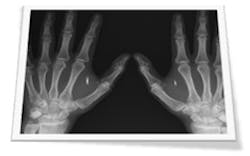I originally posted this February 8, 2009 on my Microsoft blog and thought I should share it here.
I really became interested in RFID after reading RFID Toys back in 2002. Amal Graafstra the author and I have been friends ever since, though Amal travels constantly to work with clients both nationally and internationally. The thing that really caught my attention was the RFID chips that Amal had implanted in both his hands. He uses them to open his house, car and log into his computer. He posted the pictures, video and the related interviews to the implants on his site.
With RFID tags now being read from space and used to help the blind, it is no wonder that RFID is one of the fastest growing markets around. RFID is in use all around us. There are basically three components to RFID: An antenna or coil, transceiver (decoder) and transponder (RF tag programmed w/ information)
The antenna emits radio signals to activate the tag and to read and write data to it. Antennas are the conduits between the tag and the transceiver, which controls the system’s data acquisition and communication.The transceiver and decoder to become a reader (a.k.a. interrogator), which can be configured either as a handheld or a fixed-mount device. The reader emits radio waves in ranges of anywhere from one inch to 100 feet or more, depending upon its power output and the radio frequency used. When an RFID tag passes through the electromagnetic zone, it detects the reader’s activation signal. The reader decodes the data encoded in the tag’s integrated circuit (silicon chip) and the data is passed to the host computer for processing.
RFID tags come in a wide variety of shapes and sizes. Animal tracking tags, inserted beneath the skin, can be as small as a pencil lead in diameter and one-half inch in length much like the version Amal has in each hand. Tags can be screw-shaped to identify trees or wooden items, or credit-card shaped for use in access applications.
RFID tags are categorized as either active or passive. Active RFID tags are powered by an internal battery and are typically read/write, i.e., tag data can be rewritten and/or modified. An active tag’s memory size varies according to application requirements; some systems operate with up to 1MB of memory. In a typical read/write RFID work-in-process system, a tag might give a machine a set of instructions, and the machine would then report its performance to the tag.
As in any technology that is being rapidly researched, adopted and deployed there is a security risk driven by the sheer number of units (tags) used in the marketplace. I found this quote: "The big issue that we face really is that the people driving the applications–the retailers and the consumer-products manufacturers–don’t really understand what level of security they want," says Tony Sabetti, director of supply-chain products for RFID at chipmaker Texas Instruments.
About the Author
Sign up for our eNewsletters
Get the latest news and updates



